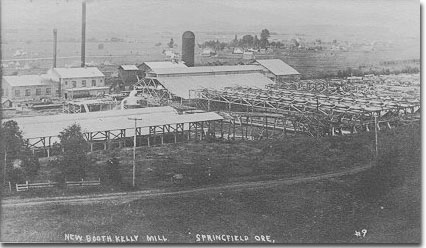Millrace (Springfield)
From Lane Co Oregon
Contents |
History
1850s
Most of the original land claims in Springfield are filed between 1851 and 1853. The average size of a claim was 320 acres. Building sites were located on the high ground because of frequent flooding. Elias Briggs began building a town. In 1852, using shovel and plow, he built the Millrace.
Originally constructed in 1852 to power Springfield's earliest industries, the Mill Race supported both timber and agriculture in the early years. Connecting naturally existing waterways, Elias Briggs, the founder of Springfield, hand-dug connections to create a waterway which would drive a saw mill and grist mill.
1890s
The company that would make Springfield a major industrial center was the Booth-Kelly Lumber Company, which was incorporated in 1896 by Robert and Henry Booth and George and Tom Kelly.
1900s
In August 1901, the Booth-Kelly Corporation purchased the Springfield sawmill and several thousand acres of timberland in the region. The sawmill was dismantled in 1902 and a larger, more efficient mill with a capacity for greater production was constructed on the same site (Clarke 1983:46).
The sawmill was not directly powered by the millrace. A steam plant was built adjacent to the millrace to power the mill with the sawdust and refuse lumber. Since this fuel was in excess of the demands for operating the plant, and destroying it would be an expense to the company, a proposition was made to the Eugene Electric Light Company to erect a light plant in Springfield with the fuel furnished by Booth-Kelly (Clarke 1983:46-48). In addition to the steam plant, Booth-Kelly created a large mill pond to store logs on the western half of the millrace.
1910s
In 1911, a brick steam plant replaced the original wooden building. In July of that year, the Booth-Kelly sawmill was destroyed by fire. The company replaced the burned remains of the old mill with a modern electric-powered mill with several buildings in 1912 (Clarke 1982:48-55).
1930s
The grist mill thrived until it burned down in 1930.
Recreational Uses
Fishing
According to Mr. Leonard Clearwater, "We used to fish the Mill Race every once in a while... go clear down as far as where 28th Street crosses the Mill Race..." When asked what type of fish he was catching, Mr. Clearwater replied, "Well, a lot of cutthroat. It was fairly shaded and cutthroat like to live back under banks and [in the] shade."
According to Mr. Robert Edmiston, "You see, this, unbeknownst to most people, this Mill Race in Springfield has one of the best salmon runs in the country. People came from up to 100 miles to go fishing and in this Mill Race, we have native cutthroat trout, we have native rainbow, and then for some reason, which is beyond anybody's understanding, the salmon came up river. And instead of staying in the Willamette River, they make a left turn and go up the Mill Race. Go over a fish ladder that's between the old Booth-Kelly Lumber, there's a fish ladder there. I did security on both ends of that place, off and on for seven years and one of my jobs was once an hour to police the salmon ladder to keep the poachers out."
Mr. Edmiston also mentions that "pond monkeys' would use their "pikes" as spears to catch salmon in the Mill Pond, "The salmon runs used to be so prolific that as they were working the Mill Pond and they saw a salmon, they would spear it with their pike. They'd take that salmon back to the lunchroom and cut it up and come evening they would stack it in their lunch pails and go home. ...Those guys used to pull salmon by the hundreds."
According to Steve Moe, "A lot of people went fishing down there."
Swimming
According to Jane Brown and Jo Anderson:
Jo: "But we always referred to it as the Mill Race. I don't know if Mr. Gorrie tacked his name on that or not. I have no idea. Okay you're looking here... and this was the swimming hole right here. If you went right back behind those trees... you were there. I used to go back there all by myself... just a little kid walking around and enjoying it. But this is... that was THE diving board... and you could dive in here and dog paddle or whatever you did right down here and there was a place to get out where it was real shallow."
Jane: "Well you know, somebody built that diving board- I have no idea who. Somebody built a little dressing room."
According to Mr. Leonard Clearwater, "...kids used to go out and swim in the Mill Race back there at 28th street- there's a bridge (Gorrie Bridge) across the Mill Race there- and that used to be a great swimming hold and there was kind of a picnic area there too." He goes to say, "A lot of the guys from the [Springfield] Plywood Plant, lunch hour or whatever- cigarette break and take a quick dip in the Mill Race."

